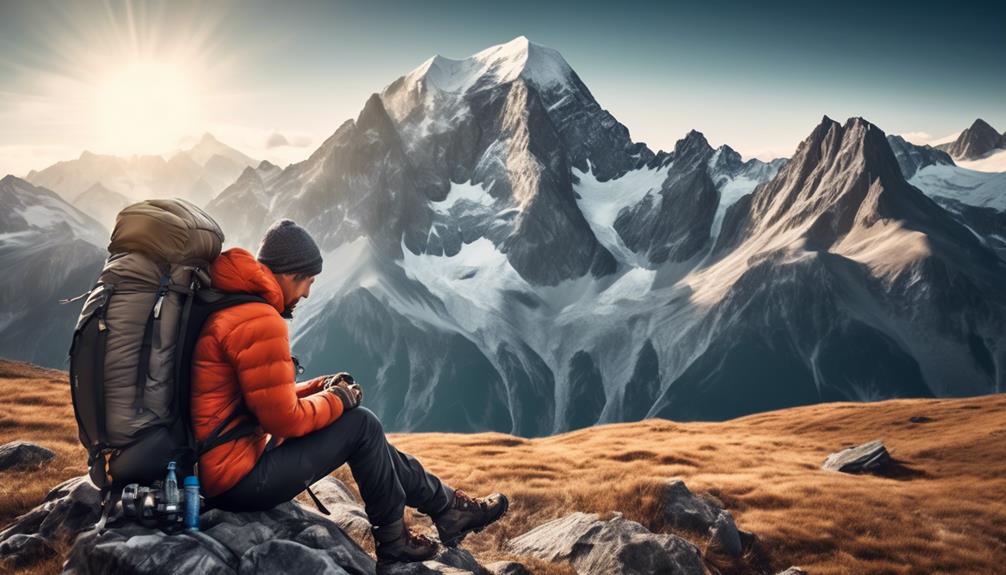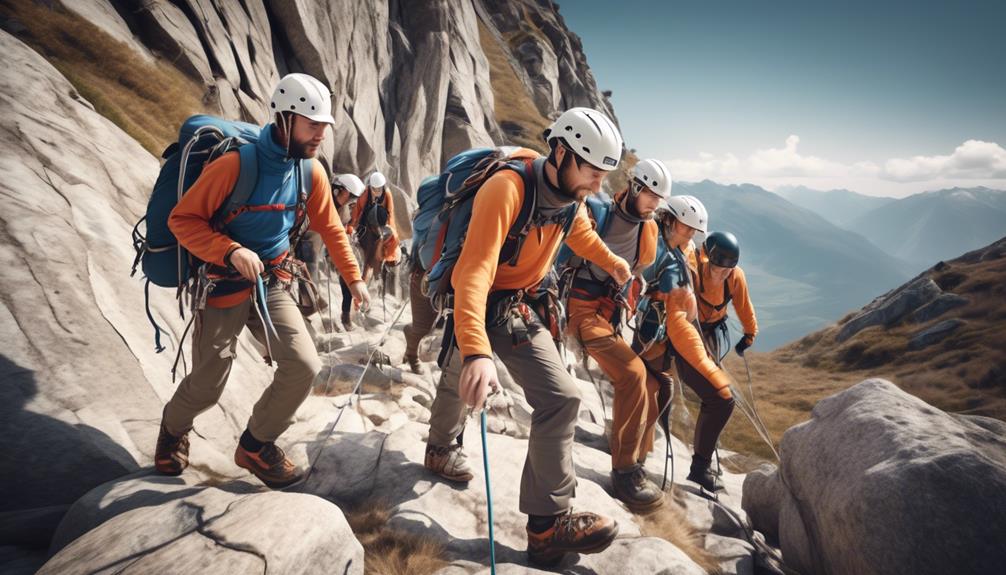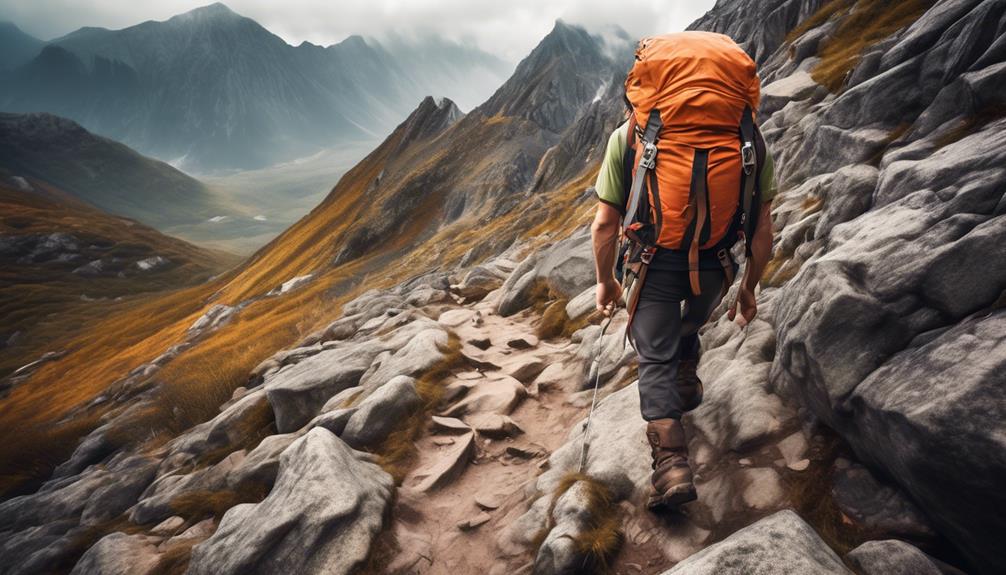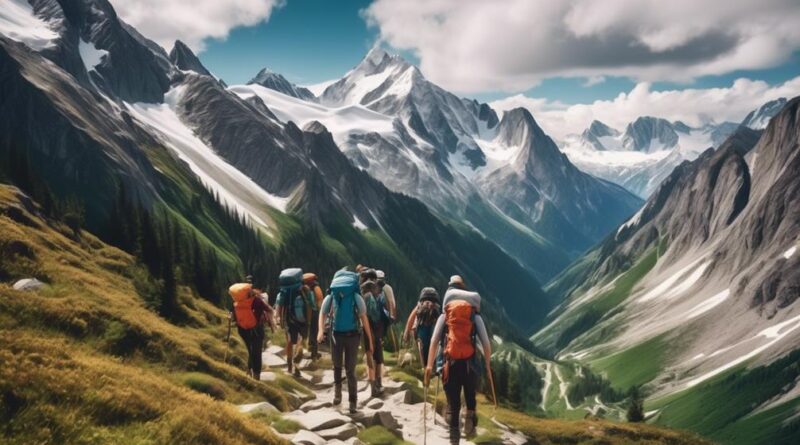Your Guide to Thrilling Mountain Trekking Journeys
You've always had a lingering curiosity about the majesty of mountain trekking, and now, you find yourself at the perfect intersection of time, opportunity, and readiness. As you stand at the threshold of this exhilarating adventure, you're about to uncover a wealth of invaluable insights and practical tips that will ensure your mountain trekking journey is nothing short of extraordinary.
But first, let's begin with the essential gear that will pave the way for a safe and thrilling exploration into the heart of the mountains.
Essential Gear for Mountain Trekking
When embarking on mountain trekking journeys, it's crucial to ensure you have the essential gear to ensure your safety and comfort while navigating the rugged terrain. Proper gear maintenance is key to ensuring that your equipment functions effectively throughout your trek. Before setting off, carefully inspect all gear and perform any necessary repairs. Additionally, research packing tips to optimize space and weight distribution, ensuring you have all the necessary items without overburdening yourself.
Weather protection is essential when trekking in mountainous regions. Pack lightweight, waterproof gear to shield yourself from the elements. Your footwear selection is also critical. Invest in sturdy, well-fitted hiking boots with excellent ankle support. Ill-fitting or subpar footwear can quickly turn a thrilling adventure into a painful ordeal. Properly breaking in your hiking boots before the trek is vital to avoid blisters and discomfort.
To maintain your gear during the trek, periodically check for any signs of wear and tear. Address any issues promptly to prevent them from escalating and compromising your safety. When packing, organize your gear logically, placing frequently used items within easy reach. This will save you time and energy when accessing your gear along the journey.
Top Mountain Trekking Destinations
Ensuring you have the essential gear and preparedness is crucial as you explore some of the top mountain trekking destinations around the world. When it comes to mountain trekking challenges, few places compare to the Himalayas. The Everest Base Camp trek offers a thrilling adventure, allowing you to witness the highest peak on the planet up close. The Annapurna Circuit in Nepal is another renowned trekking destination, famous for its diverse landscapes and unique cultural experiences.
For a different kind of challenge, consider the Torres del Paine National Park in Chilean Patagonia. This trek offers stunning vistas of snow-capped peaks, glacial lakes, and unique wildlife. Patagonia's unpredictable weather and rugged terrain make this trek a true test of endurance.
If you're seeking mountain trekking wildlife viewing, head to the Rwenzori Mountains in Uganda. This UNESCO World Heritage site is home to a variety of rare and endemic species, including the Rwenzori turaco and the Rwenzori leopard.
For a taste of the European Alps, the Tour du Mont Blanc offers a classic trekking experience with breathtaking views of the Mont Blanc massif. The trail passes through France, Italy, and Switzerland, providing an opportunity to immerse yourself in alpine culture and witness diverse flora and fauna.
These top mountain trekking destinations promise both exhilarating challenges and unforgettable wildlife encounters.
Preparing for High Altitude Trekking

To conquer high altitude trekking, it's essential to acclimatize gradually and prioritize physical fitness. The acclimatization process is crucial as it allows your body to adapt to the decreased oxygen levels at higher altitudes.
Start your preparations by focusing on cardiovascular exercises to improve your overall fitness level. Incorporate activities such as hiking, cycling, and running into your routine to build endurance and stamina. Additionally, consider incorporating strength training exercises to enhance your muscle strength, which will be beneficial during the trek.
Breathing techniques are also important for high altitude trekking. Practice deep breathing exercises to improve your lung capacity and oxygen intake. This will help you cope with the reduced oxygen levels at higher altitudes and reduce the risk of altitude sickness. Consider activities like yoga or meditation to learn breathing control and relaxation techniques.
As part of your acclimatization process, plan your itinerary to include gradual altitude gains. Ascend slowly, with planned rest days to allow your body to adjust to the altitude. Hydration is also key in the acclimatization process. Drink plenty of water to stay hydrated and aid in altitude acclimatization.
The Best Time for Mountain Trekking
Considering the weather conditions and the level of difficulty you're seeking, choosing the best time for mountain trekking is essential for a successful and enjoyable experience. Weather conditions play a crucial role in determining the best time for your mountain trekking adventure. Seasonal changes significantly impact the accessibility, trail conditions, and overall experience.
During the summer months, the weather is generally more stable, with warmer temperatures and longer daylight hours, making it an ideal time for mountain trekking. The snow has melted, allowing easier access to higher elevations and a wider range of trails. However, popular trails can be more crowded during this time. If you prefer solitude and quieter trails, consider trekking during the shoulder seasons of spring or autumn. During these periods, you can still experience favorable weather conditions, with fewer hikers on the trails.
In contrast, winter mountain trekking requires specialized gear and skills due to the challenging weather conditions. However, it offers a unique and serene experience, with snow-covered landscapes and a different set of challenges. If you're seeking a more adventurous and solitary trekking experience, winter might be the best time for you.
Ultimately, the best time for mountain trekking depends on your preferences, fitness level, and the type of experience you seek. By considering the weather conditions and seasonal changes, you can plan your mountain trekking journey for the most suitable time to ensure a safe, enjoyable, and memorable adventure.
Safety Tips for Mountain Trekking

As you plan your mountain trekking journey, prioritizing safety is crucial for a successful and enjoyable experience. When venturing into the mountains, being prepared for emergency procedures and understanding weather conditions can make all the difference.
First and foremost, familiarize yourself with emergency procedures. Always inform someone about your trekking plans and expected return time. Carry a fully charged mobile phone, a whistle, and a basic first aid kit. Knowing how to signal for help using visual or auditory cues can be lifesaving in case of an emergency. Additionally, research the emergency contact numbers for the local authorities or mountain rescue services in the area you'll be trekking.
Furthermore, pay close attention to weather conditions. Before embarking on your trek, check the weather forecast for the specific mountain area. Sudden changes in weather can be dangerous, so it's essential to be prepared for all possibilities. Dress in layers to accommodate temperature variations and pack waterproof clothing in case of rain or snow. If you encounter severe weather during your trek, seek shelter and avoid exposed ridges or summits to reduce the risk of lightning strikes or strong winds.
Choosing the Right Mountain Trekking Tour
When looking for the right mountain trekking tour, consider your fitness level, preferred trekking duration, and the level of difficulty you're comfortable with. Tour operators play a crucial role in ensuring a safe and enjoyable trekking experience. Look for tour operators with a good track record, positive customer reviews, and experienced guides. It's essential to communicate your fitness level and trekking experience honestly to the tour operator, so they can recommend a suitable trek for you.
Trail difficulty is another key factor to consider when choosing a mountain trekking tour. Evaluate your comfort level with different types of terrain, elevation gains, and technical challenges. Some tour operators offer treks with varying difficulty levels, so make sure to choose one that aligns with your abilities and preferences. Whether you're a beginner or an experienced trekker, there's a mountain trekking tour out there that's just right for you.
Before committing to a mountain trekking tour, inquire about the level of support provided during the trek. Some tour operators offer full-service treks with porters, cooks, and accommodation included, while others may require you to carry your gear and set up camp. Clarifying these details can help you choose a tour that matches your expectations and comfort level.
Health and Fitness for Mountain Trekking

If you're gearing up for a mountain trekking adventure, ensuring your health and fitness are in top condition is crucial for a successful and enjoyable experience. Before embarking on this thrilling journey, it's essential to focus on your physical conditioning and nutrition to ensure you're well-prepared for the demands of mountain trekking.
Here are some key points to consider:
- Physical Conditioning
- Start a regular cardio and strength training routine to build endurance and strength, focusing on leg muscles to prepare for uphill climbs and descents.
- Incorporate outdoor hikes and walks into your training regimen to accustom your body to varying terrains and elevations, and to break in your trekking boots for added comfort and reduced risk of blisters.
- Practice carrying a backpack with gradually increasing weight to simulate the load you'll carry during the trek, helping your body adjust to the physical demands of trekking at high altitudes.
- Nutrition Tips
- Fuel your body with a balanced diet rich in carbohydrates, proteins, and healthy fats to sustain long hours of trekking and aid muscle recovery.
- Stay hydrated by drinking plenty of water and electrolyte-rich fluids to combat the effects of high altitude and physical exertion.
- Pack lightweight, high-energy snacks such as nuts, dried fruits, and energy bars to keep your energy levels up during the trek.
Capturing Stunning Mountain Trekking Photos
To capture stunning mountain trekking photos, consistently practice framing and adjusting your camera settings to achieve the best shots in diverse lighting conditions. Utilize photography techniques to make the most of the breathtaking landscapes you encounter.
When trekking through mountains, the lighting can change rapidly, so it's essential to adapt your camera settings accordingly. Experiment with different exposure levels to capture the dramatic contrasts between light and shadow, especially during sunrise and sunset when the colors are most vibrant. Additionally, familiarize yourself with your camera equipment to maximize its potential. Understand how to use features like aperture, shutter speed, and ISO to control the amount of light entering the lens and freeze motion when needed.
In addition to mastering camera settings, composition tips are crucial for creating compelling mountain trekking photos. Use the rule of thirds to place your main subjects off-center and create a sense of depth in your images. Incorporate elements such as winding trails, towering peaks, or reflective lakes to add visual interest to your shots. Pay attention to leading lines that draw the viewer's eye into the scene, such as the curves of a mountain ridge or the flow of a river.
Frequently Asked Questions
What Are Some Common Myths or Misconceptions About Mountain Trekking That I Should Be Aware Of?
You should be aware of common misconceptions about mountain trekking, such as overestimating your abilities and underestimating the weather. Prioritize mountain safety by preparing for altitude sickness, unpredictable conditions, and the physical demands of the trek.
Are There Any Specific Cultural or Environmental Considerations to Keep in Mind When Trekking in Certain Mountain Regions?
When trekking in specific mountain regions, keep in mind cultural customs and environmental conservation. Respect indigenous traditions and practice responsible tourism. Be aware of local customs and environmental impact to ensure a positive experience for all.
What Are Some Lesser-Known Mountain Trekking Destinations That Offer Unique Experiences?
Looking for hidden gems and offbeat experiences in mountain trekking? Discover unique landscapes and local encounters at lesser-known destinations like the Tusheti region in Georgia, the Simien Mountains in Ethiopia, or the Cordillera Huayhuash in Peru.
How Can I Minimize My Impact on the Environment While Trekking in Mountainous Areas?
To minimize your impact on the environment while trekking in mountainous areas, follow leave no trace principles, use eco friendly gear, and practice sustainable practices. Pack out all waste and choose products with minimal packaging.
What Are Some Alternative Activities or Attractions Near Popular Mountain Trekking Destinations That I Should Consider Exploring?
When visiting popular mountain trekking destinations, consider exploring alternative adventures like rock climbing or paragliding. You should also indulge in local cuisine exploration to experience the flavors of the region.
Conclusion
So, get your gear ready, choose your destination, and prepare for an unforgettable mountain trekking adventure.
Remember to stay safe, be mindful of high altitudes, and capture those breathtaking moments.
With the right preparation and mindset, mountain trekking can be an exhilarating and rewarding experience.
So go out there and conquer those peaks!
